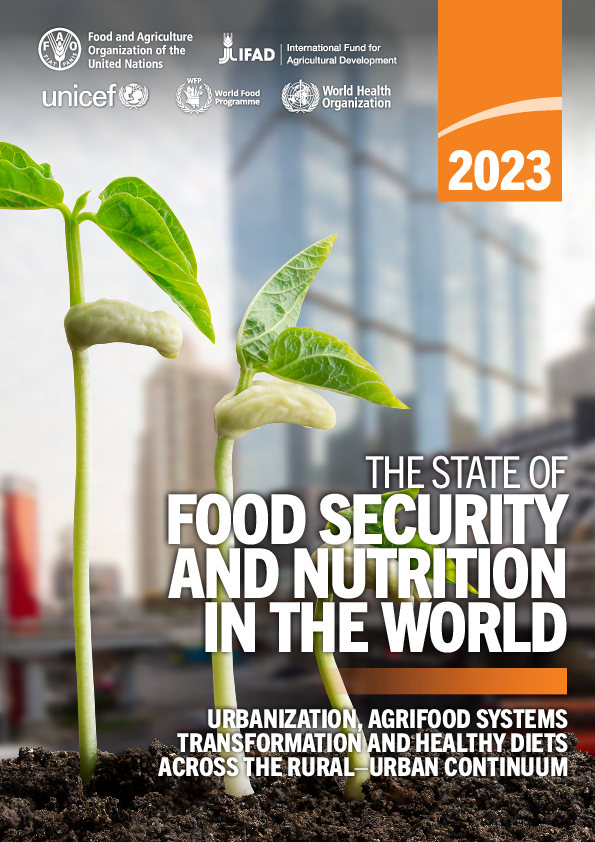 Read this article in French
Read this article in French- Share this article
- Subscribe to our newsletter
State of Food Security and Nutrition in the World 2023
If trends remain as they are, the Sustainable Development Goal of ending hunger by 2030 will not be reached, the latest State of Food Security and Nutrition in the World (SOFI) report shows. It was published in July 2023 jointly by the Food and Agriculture Organization of the United Nations (FAO), the International Fund for Agricultural Development (IFAD), the United Nations Children’s Fund (UNICEF), the World Health Organization (WHO) and the World Food Programme (WFP).
Between 691 and 783 million people faced hunger in 2022, with a mid-range of 735 million. Over 122 million more people have been facing hunger in the world since 2019 due to the pandemic and repeated weather shocks and conflicts, including the war in Ukraine, according to the report.
Hunger still on the rise in Western Asia, the Caribbean and Africa
While global hunger numbers stalled between 2021 and 2022, there are many places in the world facing deepening food crises. Progress in hunger reduction was observed in Asia and Latin America, but hunger was still on the rise in Western Asia, the Caribbean and throughout all subregions of Africa in 2022. Africa remains the worst-affected region, with one in five people facing hunger on the continent, more than twice the global average.
The report finds that approximately 29.6 per cent of the global population, equivalent to 2.4 billion people, did not have constant access to food, as measured by the prevalence of moderate or severe food insecurity. Among them, around 900 million individuals faced severe food insecurity.
Access to healthy diets has deteriorated
Meanwhile, the capacity of people to access healthy diets has deteriorated across the world. More than 3.1 billion people – or 42 per cent of the world population – were unable to afford a healthy diet in 2021. This represents an overall increase of 134 million people compared to 2019.
Millions of children under five continue to suffer from malnutrition. In 2022, 148 million children under five years of age (22.3 per cent) were stunted, 45 million (6.8 per cent) were wasted, and 37 million (5.6 per cent) were overweight.
Progress has been seen in exclusive breastfeeding, with 48 per cent of infants under six months of age benefiting from this practice, close to the 2025 target. However, more concerted efforts will be required to meet the 2030 malnutrition targets.
People in rural areas suffer most from food insecurity
The report also looks at increased urbanisation as a ‘megatrend’ affecting how and what people eat. The simple rural and urban divide concept is no longer sufficient to understand the ways in which urbanisation is shaping agrifood systems, according to the authors. A more complex rural-urban continuum perspective is needed considering both the degree of connectivity that people have and types of connections that exist between urban and rural areas.
The report illustrates that food purchases are significant not only among urban households but also across the rural-urban continuum, including people residing far from urban centres. The new findings also show how consumption of highly processed foods is also increasing in peri-urban and rural areas of some countries.
Unfortunately, spatial inequalities remain. More people living in rural areas are threatened by food insecurity. Moderate or severe food insecurity affected 33 per cent of adults living in rural areas and 26 per cent in urban areas.
Children’s malnutrition also displays urban and rural specificities: the prevalence of child stunting is higher in rural areas (35.8 per cent) than in urban areas (22.4 per cent). Wasting is higher in rural areas (10.5 per cent) than in urban areas (7.7 per cent), while overweight is slightly more prevalent in urban areas (5.4 per cent) compared to rural areas (3.5 per cent).
The report recommends that to effectively promote food security and nutrition, policy interventions, actions and investments must be guided by a comprehensive understanding of the complex and changing relationship between the rural-urban continuum and agrifood systems.
(FAO/ile)
Read more and download the report on the FAO website





Add a comment
Be the First to Comment